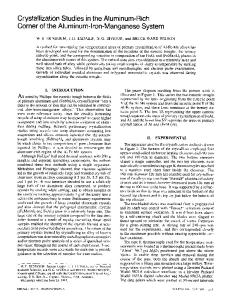Iron intermetallic phases in the Al corner of the Al-Si-Fe system
- PDF / 2,010,351 Bytes
- 19 Pages / 612 x 792 pts (letter) Page_size
- 55 Downloads / 336 Views
TION
COMMERCIAL unalloyed aluminums and aluminumbase alloys contain a considerable amount of iron and silicon as impurities or alloying additions. Commercial aluminum alloys, which have up to 1 pct of iron and silicon, can be considered ternary alloys. Because the solid solubility of iron in aluminum is less than 0.05 pct at equilibrium, nearly all iron in aluminum alloys forms second-phase particles. Both iron and silicon have partition coefficients less than unity, and accordingly segregate to the liquid between the Al dendrite arms during the course of solidification. Therefore, when considering the nonequilibrium lever-rule assumption,[1] primary particles of binary Al-Fe and ternary Al-Fe-Si phases, and even silicon, can form during casting of an aluminum-rich alloy. The chemical composition and local cooling rate are the controlling factors that determine which phases will form[2,3] and their particle size.[4,5] An extensive review of the Al-Fe-Si system has been published by Rilvin and Raynor.[6] Several studies by other workers,[7,8,9] have focused upon the Al-rich part of the system, where the u-Al3Fe, a-AlFeSi, and b-AlFeSi phases have been reported as equilibrium phases.[9,10] In addition, some nonequilibrium phases have been identified, for example, W. KHALIFA, Ph. D. Student, and F.H. SAMUEL, Professor, are with the Département des Sciences Appliquées, University of Quebec at Chicoutimi (UQAC), Chicoutimi, PQ, Canada G7H 2B1. Contact e-mail: [email protected] J.E. GRUZLESKI, Professor, Department of Mining, Metals and Materials Engineering, and Dean, Faculty of Engineering, is with McGill University, Montreal, PQ, Canada H3A 2B2. Manuscript submitted March 15, 2002. METALLURGICAL AND MATERIALS TRANSACTIONS A
metastable phases such as Al6Fe,[3,11,12] Alm Fe,[13,14] and AlxFe[3,15] instead of the u-Al3Fe (or u-Al13Fe4)[16,17] equilibrium phase. Structures of various phases, e.g., Al6Fe,[13,18] Al3Fe,[11,19] and a-AlFeSi[20,21,22] have been investigated. The complex structure of AlmFe has also been suggested.[23,24] Without doubt, the binary Al-Fe and ternary Al-Fe-Si phases constitute an important part of the microstructure in aluminum alloys. Particles formed during casting may influence the material properties during subsequent fabrication steps or in service. For example, the b-AlFeSi platelike phase has a detrimental influence on the alloy properties. The b-phase platelets act as potential sites for crack initiation, which, consequently, results in decohesion failure.[25] Other phases such as Al3Fe and a-AlFeSi are cathodic to the aluminum matrix, and when present on the surface, promote pitting attack of the surface in conductive liquids.[26] Thus, control of these phases is of considerable technological importance. In view of the importance of iron intermetallic phases in aluminum alloys, this study was carried out to characterize their precipitation as affected by (1) the chemical composition, through the use of six dilute alloys covering the Al corner of the Al-Si-Fe system, and (2) the cooling ra
Data Loading...











